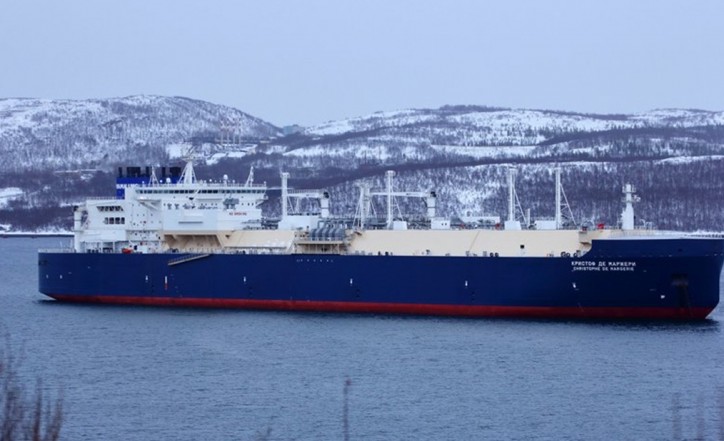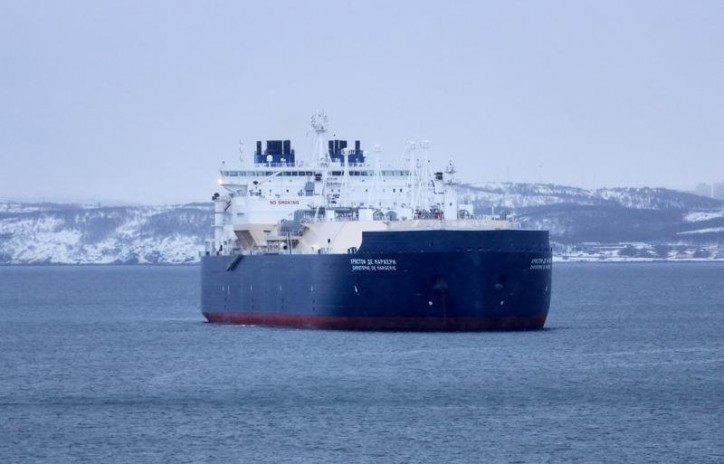Christophe de Margerie, the world’s first ice-breaking LNG tanker, has successfully berthed at the gas terminal at Sabetta Port in Russia, becoming the first vessel to do so. The vessel was designed to order for SCF Group, specifically to serve Russia’s Yamal LNG project, and transport LNG all year round in the difficult ice conditions of the Ob Bay and Kara Sea.
On 30 March the vessel’s master, Sergey Zybko, reported to Russian President Vladimir Putin the successful completion of ice trials and the first mooring at the Yamal LNG terminal at Sabetta. The ceremony was attended by Maxim Sokolov, Russia’s Minister of Transport, Alexey Texler, First deputy Minister of Energy, Li Fanzhun, Deputy Head State Energy Administration People’s Republic of China, Leonid Mikhelson, Chairman & CEO of Novatek, Patrick Pouyanné, Chairman & CEO of Total, and Sergey Frank, President & CEO of SCF Group.

LNG Carrier Christophe de Margerie - Image courtesy of Gazprom
“I should like to congratulate everyone on today’s event. I congratulate the Russian participants and our foreign partners. The arrival of this new tanker, designed for Arctic conditions, is a big event in Arctic development, as is the construction of the port of Sabetta, where the tanker docked today. The port was built entirely from scratch” said Vladimir Putin in his salutary address.
“I should like to draw your attention to the fact that in developing the Arctic’s enormous wealth, our basic principle is not to cause any harm. We realise that this region’s ecosystem is very sensitive to any human interference. But I know your work in detail and I know for certain that the port, the ships that will use it, the production methods used, and the transportation system all use the most advanced technology and meet the highest environmental standards. The first of the new ships docked today. Fifteen of these ships will be built in total, with the involvement of Russian shipbuilders”, said Vladimir Putin.
“It is with pleasure that I note that this new ice-class ship, which is one of its kind in the world, bears the name of our late great friend, French businessman and former head of Total, Christophe de Margerie, who so tragically left this life”, added Vladimir Putin.
The specifications of Christophe de Margerie make her a unique vessel. She was assigned an Arc7 ice class, the highest ice class amongst existing merchant vessels. The vessel is capable of sailing independently through ice up to 2.1 metre thick. Christophe de Margerie can sail along the Northern Sea Route westward from Sabetta all-the-year-round and eastward for six months of the year (from July to December). Previously, the summer navigation window on the Northern Sea Route was limited to only four months with ice-breaker support.
The total power of the vessel’s propulsion system is 45 mW. For comparison, the world’s first nuclear-powered ice-breaker, Lenin, had a power output of only around two thirds of this figure at 32.4 mW.
In just one voyage, the vessel can carry 172,600 m3 of LNG, which is sufficient to supply the country of Sweden with all its gas requirements for almost four weeks. The vessel is 299 metres long (equal to the height of the Eiffel Tower) and 60 metres high (comparable to the height of a 22-storey building).
The crew of the ship numbers 29, all of whom are Russian seafarers and 13 of which are officers. On top of the significant Arctic shipping experience each officer has, he or she has undergone extensive training at Sovcomflot’s own training centre in St. Petersburg.

LNG Carrier Christophe de Margerie
“Today’s events are the result of a painstaking and thorough collaboration between Sovcomflot, Novatek, and Yamal LNG which took close to ten years. A project of this scale and complexity required a thorough evaluation of all the details. This is fully justified: the Arctic does not forgive those that rush and lack professionalism. The starting point was the the successful experience of SCF Group working in energy projects in the Barents and Pechora Seas, as well as two experimental transit voyages along the Northern Sea Route, undertaken by Sovcomflot and Novatek in 2010-2011 with the support of Russia’s Ministry of Transport and Atomflot. Together, we have proven that using high-latitude routes as a transport corridor, for large-capacity vessels, is not only technically possible but also economically feasible. In many ways, these results have laid the foundation for the successful implementation of the Yamal LNG project, which would have been impossible without an efficient and safe logistics scheme to transport LNG by sea,” Sergey Frank said.
"Construction of the Sabetta Port is based on the principles of public-private partnership and is the world’s largest infrastructural project being implemented in the Arctic latitudes today. The total volume of investments is 108 billion rubles, where 72 billion rubles are resources from the federal budget, and a third comes from private investment. Now the port is actually operating under normal conditions. The full-scale implementation of this project not only has allowed building the LNG plant, but also has strengthened the position of the Russian Federation in the Arctic, and contributed to the development of the Northern Sea Route”, Maxim Sokolov noted.
“This region is the richest location in terms of its reserves. It is possible to produce more than 70 million tonnes of LNG and create a hub with a more than a 15 per cent share in the world market in terms of its cost here. The new infrastructure will help implement this goal in the shortest possible time”, Leonid Mikhelson emphasised.
Christophe de Margerie is the prototype for a series of 15 gas carriers, which are planned to be constructed for the Yamal LNG project. The appearance of this particular gas carrier signalled the market debut for Yamalmax ships, a new class of vessel.
The propulsion system of the new gas carrier consists of Azipod type propulsion units. They provide a very high degree of manoeuvrability, and allow use of the stern-first motion (Double Acting Tanker, DAT function) principle, which is necessary to overcome hummocks and heavy ice fields. Uniquely Christophe de Margerie has three Azipods – this is the first time so many of these propulsion units have been installed on an Arctic ice class vessel.
The exceptional ice-passing and manoeuvring qualities of the new vessel were fully confirmed by her ice trials, which took place from 19 February to 8 March 2017 in the Kara and Laptev Seas. During the trials, the vessel managed to exceed a number of indicators:
- The vessel proved her capability to move stern-first in 1.5 metres thick ice at a speed of 7.2 knots (target figure was 5 knots) and head-on at a speed of 2.5 knots (target figure was 2 knots);
- The turning circle of the ship in 1.7 metres thick ice was 1,760 metres against the planned 3,000 metres.
Ice trials were attended by participating representatives of the shipyard (Daewoo Shipbuilding & Marine Engineering), key equipment suppliers (primarily ABB, producer of the Azipods), leading industry research and design organisations, both Russian ones (Arctic and Antarctic Research Institute, Krylov State Research Centre) and international ones (Aker Arctic Research Centre, Hamburg Ship Model Basin).
During her maiden call at Sabetta Port, the vessel successfully carried out a trial passage through the purpose-built seaway canal, the most difficult part of the Ob Bay in terms of navigation. The canal was created at the confluence of the Ob River in the Kara Sea, to allow large-capacity vessels to cross the shoal at the river mouth. This engineering structure, unique for the Arctic basin, is intended to be operated in difficult conditions of constant ice drift. The canal’s depth is 15 metres, its width is 295 metres, and length is 50 kilometres.
The vessel was built according to all requirements set by the Polar Code and is notable for her environmental safety. In particular, for example, along with traditional fuels the vessel can use LNG boil-off. Compared with conventional heavy fuel, the use of LNG can significantly reduce the emissions of harmful gases into the atmosphere: sulphur oxides (SOx) reduced by 90%, nitrogen oxides (NOx) reduced by 80% and carbon dioxide (CO2) emissions down by 15%.
Related news:
Russia's first ice-breaking LNG carrier Christophe de Margerie heads for ice trials
World’s first top category ice class LNG carrier calls at Zeebrugge LNG terminal
Source: Sovcomflot